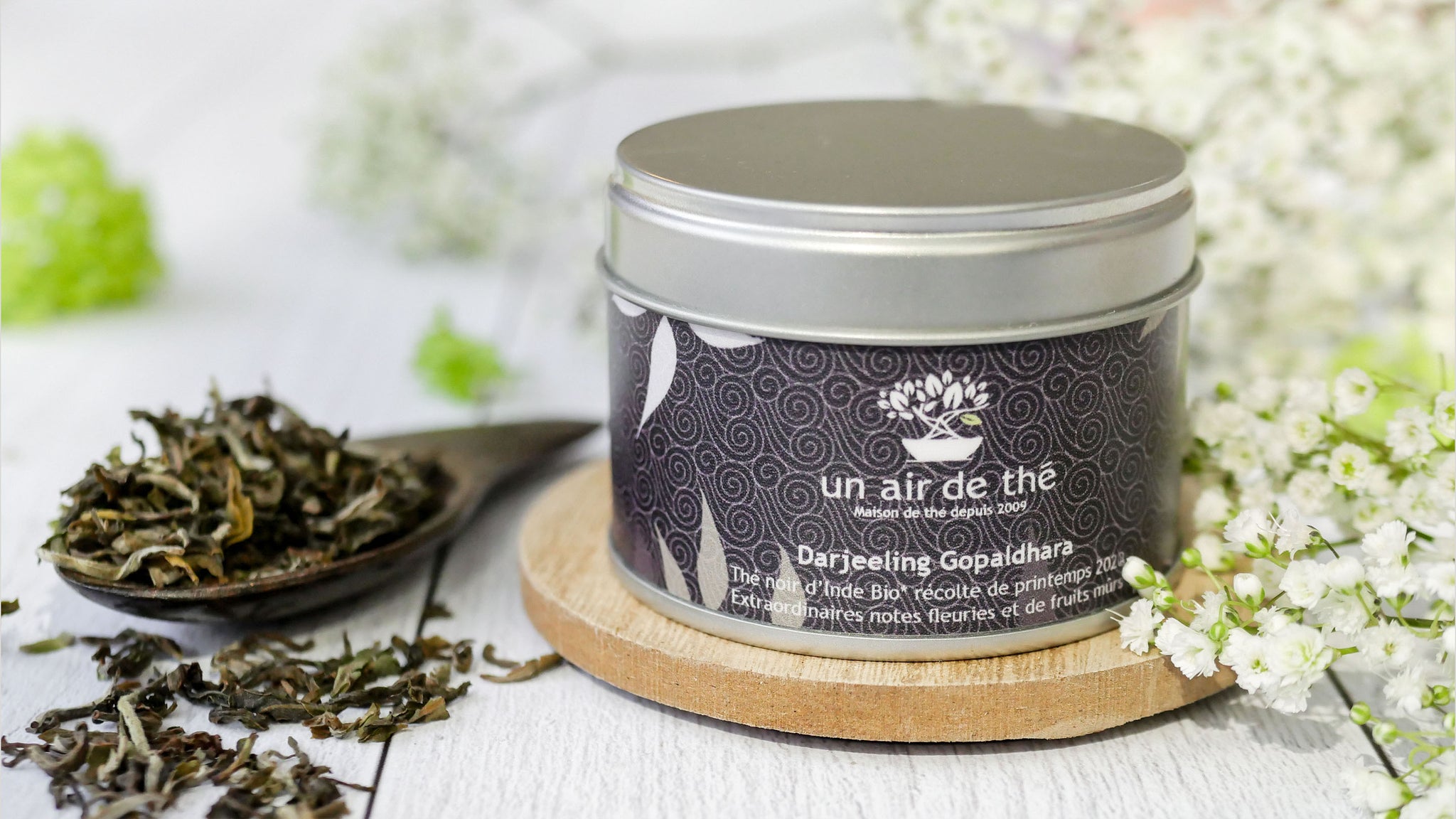Qu'est-ce qu'un Thé Grand cru ? Comment les définir et les sélectionner ?

« Le thé est un art »
Tel le décrivait Lu Yu (733-804), penseur/poète chinois, dans une de ses œuvres majeures, le Cha Jing ou le Classique du thé datée de 780.
Semblable à l’univers du vin en France,
l’histoire d’un Grand cru de thé prend source dans la terre, avec des notions de terroir, d’espèces et de variétés. Il prend forme avec une botanique et une agriculture évoluées, parfois sauvages et souvent maîtrisées par l’Homme.
I- Les Thés Grands crus, des thés exceptionnels issus de terroirs théicoles.

Dans le même esprit qu’un vin, un thé Grand cru est avant tout le reflet d’une typicité d’un pays, d’une région et de l’ensemble des caractéristiques que forment un terroir. Pas toujours facilement identifiables, les thés Grands crus ont pourtant une carte d’identité bien à eux.
-
Quels sont les pays producteurs de thés Grands crus ?
En premier lieu, le pays. Véritable empreinte géographique, celui-ci détermine souvent l’identité générale du thé. Son histoire, plus ou moins ancienne, sa réputation ou encore son identité propre autour de la route du thé lui donnent une légitimité naturelle.
Il reste inévitablement un des premiers axes de choix pour certains thés Grands crus emblématiques.
Certains pays majeurs dans la culture thé, comme la Chine, l’Inde, Ceylan ou bien encore le Japon, ont marqué fortement de leurs empreintes les types, les noms ou encore les caractéristiques de goûts de leurs Grands crus emblématiques.
-
Quelles sont les régions créatrices de thés Grands crus ?
Vient ensuite la région, qu’on peut appeler également la province ou le district. C’est le second point d’identification pour un thé Grand cru. Certaines régions sont très fortement précédées par leur réputation, comme le Darjeeling avec son thé de printemps Gopaldhara, le nord de l’Inde avec l’Assam, la Chine et son légendaire thé vert Long Jing « Puit du Dragon » du Zhejiang, Taïwan avec son emblématique thé Oolong « Oriental Beauty » ou bien encore la province d’Uji au Japon et son magnifique thé vert Gyokuro « Perle de rosée ».
Chaque région essaie, plus ou moins bien, de mettre en avant ses spécificités dans la production de thés Grands crus. Ceci afin de rayonner sur le plan international et ainsi d’accentuer son image premium dans cette niche qu’est la manufacture de thés Grands crus. C’est un peu notre Champagne.

-
Le thé Grand cru, au coeur de certains jardins de thé.
Le jardin de thé... Il est l’équivalent du château dans notre culture du vin. Il nous éclaire plus finement sur l’identité que peut revêtir un thé Grand cru. C’est ici la partie affinée du terroir qui se joue.
Souvent plus forte que celle de la région, l’identité d’un jardin marquera une empreinte prononcée sur le caractère d’un thé Grand cru produit en son sein. Certains connaisseurs de thés Grands crus se réfèrent quasi-aveuglement à certains jardins tant leur qualité de manufacture touche l’excellence. Leurs réputations ne sont plus à faire.

-
Choisir son thé Grand cru en fonction de son cultivar
Enfin, l’espèce ou le cultivar. Connu sous le nom de cépage dans l’univers du vin, le cultivar est l’exact équivalent dans le monde du thé. Il est la variété qui a été sélectionnée en amont de la plantation pour la culture du thé. Elle détermine pour beaucoup la typicité du thé. Celle-ci peut être une espèce ancienne non modifiée ou bien un assemblage, dit hybride, obtenu par clonage ou bouturage. Il n’existe que très peu d’espèces mais des centaines voire des milliers de variétés. Certaines très connues pour leur stabilité, comme le Yabukita pour le thé vert japonais, d’autres pour leur goût typique ou atypique, comme peut l’être le AV2 des Darjeeling, et d’autres enfin pour leur rareté car très peu utilisées, comme le Seimei pour le thé Gyokuro japonais.

Les multiples combinaisons des nombreuses caractéristiques qui forment un Grand cru de thé offrent ainsi une très grande variété de crus ainsi qu’un champ des possibles quasi-infini.
II- Les Thés grands crus, le fruit du travail de nombreux acteurs.
Bien loin de l’univers du sachet de thé industriel que l’on infuse négligemment dans un mug, sans se soucier, ni de ce qu’il peut y avoir dedans, ni d’une éventuelle méthode de préparation, un Grand cru de thé empruntera un tout autre chemin pour arriver jusqu’à votre tasse.
Pour cela, le terroir et la botanique sont importants mais bien insuffisants sans le travail et l’expertise des acteurs du thé.
-
La récolte minutieuse des Thés Grands crus
Pour commencer à parler de thés Grands crus, la première étape très importante est bien celle de la récolte, appelée la cueillette.
C’est réellement l’étape où entrent en action les mains des cueilleuses. En effet, dans de nombreux pays majeurs du thé, comme la Chine ou l’Inde seules des femmes ayant eu un long apprentissage et dont l’expérience et la minutie de leurs gestes ont été prouvées, pourront être habilitées à récolter les feuilles de thé les plus fines. Et plus encore s’il s’agit d’une récolte dédiée à la fabrication d’un thé Grand cru. Les hommes restent bien souvent cantonnés dans des rôles plus physiques, comme le portage, le pesage ou la logistique. Ils n’auront qu’à de rares occasions le droit de pratiquer la cueillette, souvent par pénurie de main-d’œuvre, et pour des productions de thés bien plus standards, voire bas de gamme.
Généralement, une cueillette très spécifique, appelée « cueillette Impériale ou cueillette Fine » est absolument nécessaire pour la fabrication d’un thé Grand cru. C’est uniquement la sélection des feuilles les plus gorgées d’huiles essentielles et au plus fort potentiel aromatique qui seront cueillies.
Ces feuilles seront manipulées avec la plus extrême délicatesse pour ne pas être abîmées.

-
Les Thés Grands crus, une manufacture de précision.
Une fois la cueillette effectuée, le temps sera venu de la manufacture. Il s’agit là de l’ensemble des étapes de transformation des feuilles de thé pour les amener à leur état final, avant qu’elles soient infusées.
C’est bien l’étape cruciale qui déterminera le type du thé Grand cru que l’on souhaite fabriquer (thé noir, thé vert, thé blanc, thé jaune, thé Oolong, thé Pu’er), mais aussi le caractère organoleptique que l’on souhaite lui voir prendre.
La manufacture est réalisée par des personnes expérimentées, sous l’intendance et la surveillance du responsable de production, appelé le superviseur. Il est généralement la personne la plus importante, la plus expérimentée de la factory (l’unité de fabrication), et a toute la confiance du propriétaire de la plantation qui bien souvent ne gère que l’aspect financier. Le superviseur est un peu le Maître de chai dans un château de vin, donc un maillon essentiel pour la qualité du produit.
C'est seulement, une fois la manufacture menée à son terme, que le Grand cru de thé apparaîtra.
Il sera testé, expertisé, évalué afin de lui donner son rang et son prix de vente final.

III- Les Thés Grands crus, des thés rares de dégustation
-
Combien coûte un thé Grand cru ?
Une fois que l’on a connaissance qu’un thé Grand cru est un thé rare, exceptionnel, aux parfums hors du commun, à la fascinante tenue en bouche, et qu’il est extrêmement difficile de réunir toutes les conditions nécessaires pour le fabriquer, on se dit qu’il y aura forcément un prix à payer. C’est vrai. Mais en y regardant de plus près, une rapide comparaison avec un Grand cru de vin, nous éclaire rapidement sur le fait qu’un Grand de thé n’est pas synonyme d’inaccessibilité. En effet, le coût d’une tasse d’un Grand cru de thé est bien moins onéreux qu’un verre d’un Grand cru de vin. Il y a bien entendu dans les deux catégories des prix qui ne s’expliqueront jamais, sauf à y voir de la spéculation. Mais dans une généralité commune, un thé Grand cru peut se payer entre 1,5€ et 5€ la tasse alors qu’un Grand cru classé de vin atteint facilement les 15€ à 50€ le verre. Le luxe de mettre un Grand cru de thé dans sa tasse reste donc relativement accessible, surtout quand il est vendu en sachet de 50g, là où un thé plus standard sera vendu communément en sachet de 100g.

-
Attention au marketing "Grand cru" !
Avant de se laisser aller à chiner son thé Grand cru, il est également important de noter que dans l’univers du thé, l’appellation de « Grand cru » est régulièrement mal employée pour ne pas dire usurpée par certaines marques de thé bien connues pour leur passion du marketing bien ciblé. En effet, il n’est pas rare de voir écrit « Grand cru » sur des sachets ou des boîtes de thé n’en étant simplement pas. Pour exemple, lorsque l’on ajoute des ingrédients, même dits « rares et luxueux » comme des paillettes d’or, il est bien entendu qu’il ne s’agit là aucunement de Grands crus de thé. Un Grand cru de thé ne doit être composé que des seules feuilles de thés d’une qualité et/ou provenance respectant le cahier des charges que nous avons abordé en I et II. Le reste sera classé comme publicité tendancieuse avec pour but de faire vendre un produit fantaisie sous une étiquette plus luxueuse. Nous serons là bien éloignés de la découverte d’un cru d’une origine, d’un terroir, d’un caractère et d’une typicité.
La conception et la fabrication d’un thé Grand cru s’approche très clairement de celle de l’orfèvrerie. L’ensemble des conditions nécessaires ainsi que le travail des personnes en charge de sa fabrication sont indéniablement là aussi des éléments d’un grand savoir-faire.
IV- La préparation, l’ultime étape ! Comment préparer un thé Grand cru ?
En effet, après avoir mis en lumière les conditions difficiles et le travail nécessaire pour obtenir un thé Grand cru, il est de bon usage d’appliquer quelques règles d’or pour sa préparation.
C’est à ce moment-là que l’on prend conscience que nous sommes le dernier maillon, après la longue route que le thé a suivi jusqu’à nous, pour la réussite de la dégustation.
- Les 4 règles d'or pour préparer un thé : le dosage, la qualité de l'eau, la température de l'eau et le temps d'infusion.
Ce n’est que l’ensemble de ces conditions réunies qui mettront en valeur tout ce que la nature aura donné aux feuilles de thé, ce que les acteurs du thé auront mis comme passion et savoir-faire dans leur travail, ce que nous aurons modestement accompli en sourçant ce thé et ce que vous-même aurez comme plaisir en dégustant un véritable Grand cru de thé.
-
Certains thés Grands crus sont des "thés de garde "
Ces thés de garde, en marge des autres thés, vont pouvoir en fonction des différentes méthodes de fabrication vieillir plusieurs dizaines, voire centaines d’années. En fonction des conditions dans lesquelles ces thés seront conservés, le vieillissement aura pour effet de bonifier le thé. Il pourra alors prendre la voie des Grands crus, avec la spéculation qui ira avec.
-
Certains thés primeurs sont des Grands crus
Les thés primeurs de printemps ont généralement un grand succès. La saison de récolte assez courte couplée à une demande très importante fait chaque année s’envoler les prix.
-
Les thés Grands crus à accorder comme des vins






Leave a comment